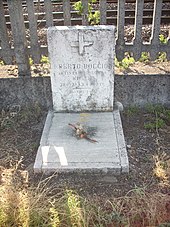Umberto Boccioni
Umberto Boccioni (born October 19, 1882 in Reggio Calabria (Italy), † August 17, 1916 near Verona ) was an Italian painter and sculptor of Futurism .
life and work
Boccioni went to Rome in 1901 , studied design and attended the Scuola Libera del Nundo at the Accademia di Belle Arti . He and Gino Severini learned the techniques of Divisionist painting from his teacher Giacomo Balla . In 1902 he traveled to Paris to study impressionist and post-impressionist painting. After traveling to Russia in 1906, Boccioni visited Padua and moved to Venice , where he spent the winter of 1906/07 studying nudes at the Accademia di Belle Arti . In 1907 he moved to Milan , where he met Carlo Carrà , Luigi Russolo and Filippo Tommaso Marinetti , who published the first futuristic manifesto in February 1909 . Together with these, Boccioni published together with Giacomo Balla and Gino Severini in 1910 the Manifesto of the Futurist Painters and the Technical Manifesto of the Futurist Painters .
In autumn 1911 the artist moved to Paris , where he met Pablo Picasso and Guillaume Apollinaire through Gino Severini's mediation . In 1912, Boccioni's paintings were shown at the “first futuristic exhibition” in the Bernheim-Jeune gallery in Paris, along with those by Carrá, Russolo and Severini. In 1914, his Technical Manifesto of Futurist Painters was also published in Moscow .
The central idea in Boccioni's work was the relation and tension between the object and the surrounding space. He denied the concept of firmly defined lines and closed sculpture ; the object should be broken open and, as it were, enter the room . He calls his titles about horse + rider + building or houses + light . This approach both in the representation and in the naming was adopted by Lubow Popowa .
An image of his sculpture Unique forms of continuity in space (Forme uniche della continuità nello spazio) is now on the Italian 20-cent piece . Some of his works were shown posthumously at documenta 1 (1955), documenta II (1959) and documenta III in 1964 in Kassel .
In 1911 he created the painting The street penetrates the house (currently in the Sprengel Museum in Hanover ), which gave the name to the great futurism exhibition The noise of the street in Hanover (2001).
Boccioni died in World War I in 1916 when he fell from his horse during an exercise near Verona and was fatally injured in the process.
Works
Simultaneous visions , around 1912
literature
- Thomas Krens (preface): Rendezvous. Masterpieces from the Center Georges Pompidou and the Guggenheim Museums . Guggenheim Museum Publications, New York 1998, ISBN 0-89207-213-X
- Umberto Boccioni - Speed as a new category of sculpture . In: Markus Stegmann: Architectural Sculpture in the 20th Century. Historical aspects and work structures , Tübingen 1995, pages 53–58.
- Book for the exhibition 16. Russian Avantgarde 1910–1930 Collection Ludwig, Cologne , in the Kunsthalle Cologne, April 16 - May 11, 1986 (edited and with an introduction by Evelyn Weiss ), ISBN 3-7913-0766-5
- Danih Meo: Della memoria di Umberto Boccioni , Mimesis, Milano 2007, ISBN 978-88-8483-595-6
Web links
- Literature by and about Umberto Boccioni in the catalog of the German National Library
- Artcyclopedia
- Short biography (English) with catalog raisonné
- biography
- Materials by and about Umberto Boccioni in the documenta archive
Individual evidence
- ↑ Futurism and Fascism ( Memento of April 27, 2011 in the Internet Archive ), heise.de, accessed on June 25, 2012
| personal data | |
|---|---|
| SURNAME | Boccioni, Umberto |
| BRIEF DESCRIPTION | Italian painter and sculptor |
| DATE OF BIRTH | October 19, 1882 |
| PLACE OF BIRTH | Reggio Calabria , Italy |
| DATE OF DEATH | August 16, 1916 or August 17, 1916 |
| Place of death | near Verona |






